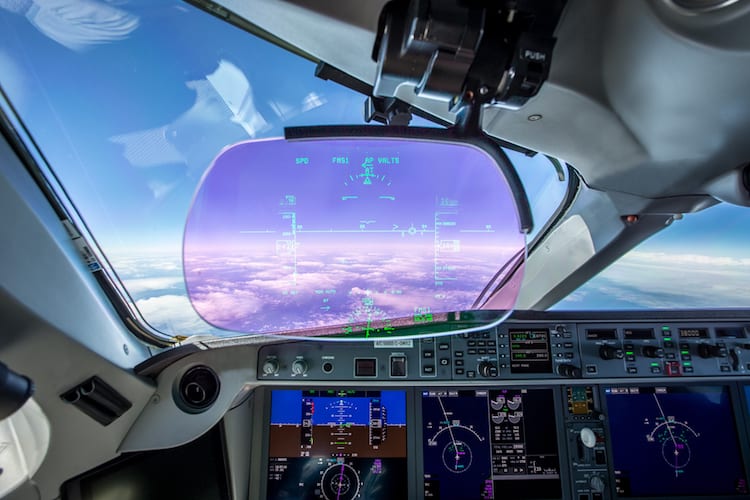
Airbus A220-100 cockpit with head up display (HUD). Photo: C Series Aircraft Limited Partnership.
At SAE Industry Technologies Consortia’s upcoming 2019 Airlines Electronic Engineering Committee (AEEC) mid-term session in Seattle, some of the commercial aviation industry’s leading avionics engineers are expected to adopt four new ARINC Standards.
AEEC is one third of the aviation industry activities committees that are hosted by ARINC Industry Activities under SAE International, which also includes the Avionics Maintenance Committee (AMC) and the Flight Simulator Engineering and Maintenance Committee (FSEMC). Throughout the year, these engineers from various parts of the industry collaborate bi-annually at a general session and mid-term conferences, and independently in subcommittee standard development work.
Paul Prisaznuk, AEEC’s executive secretary and program director, said the committee expects to adopt four new standards at its mid-term meeting hosted by Boeing in Seattle, Washington Oct. 11-12.
“These include supplements to aviation satcom standards ARINC 741 and ARINC 761. AEEC will consider guidelines on cabin passenger seat testing in ARINC 648. Avionics Digital Video Bus (ADVB) standards are expanded to support speeds up to 28 Gbps in ARINC 818,” Prisaznuk said.
ARINC standards or characteristics define the form, fit, function and interfaces of modern avionics systems. The standards are divided into two series, the ARINC 700 series for digital avionics and the 500 series for analog avionics. Then there are ARINC specifications, which are principally used to define either the physical packaging or mounting of avionics equipment or data communications standards or a high-level computer language.
ARINC 741 refers to a standard ARINC uses to define the system design and equipment functional description for satellite data units, which enable data transmissions between aircraft antennas and satellite networks. ARINC 648 is in project paper status under the Cabin Systems Subcommittee, which describes the project as the development of recommended practices for cabin seat production testing. Testing requirements developed would assure hat line replaceable units in the seat operate in an integrated fashion and the roles of the parties involved in seat systems integration are defined.
“Seat and system suppliers minimize troubleshooting and rework when seats are delivered tested and functional to the airframe manufacturers,” a description of the project paper notes.
Prisaznuk said AEEC is also preparing to develop several new ARINC Standards in 2020 including one for advanced airborne weather radar technology, as well as a new standard that will serve to define the technological specifications of a second-generation integrated surveillance system.
Among the upcoming AEEC events this fall where hundreds of airline and avionics equipment maker engineers will gather to define the design of the next generation of avionics systems, include the AEEC Data Link Users Forum September 17 to 19th in Dublin, Ireland and the EFB Users Form, November 5th to 7th in Madrid, Spain.